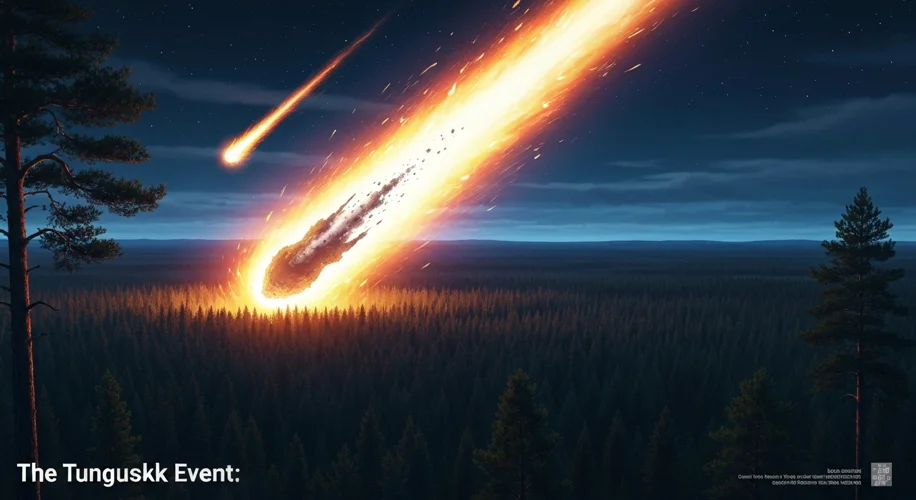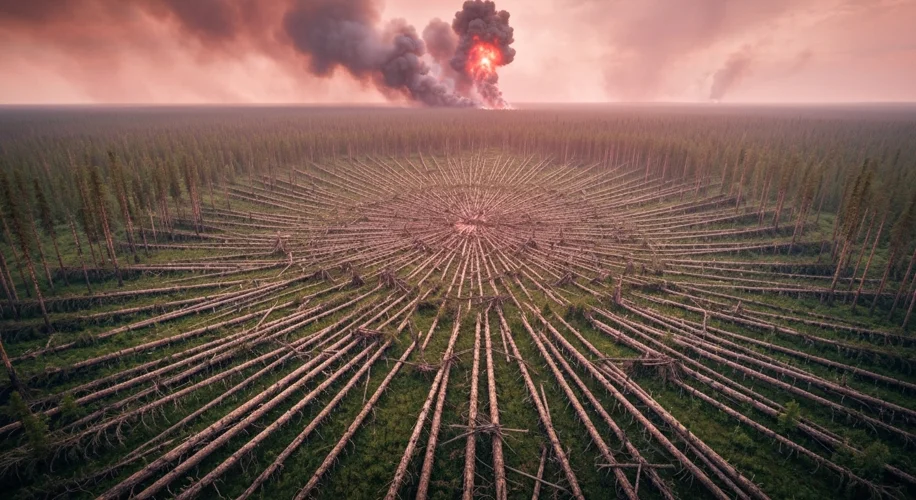Try to imagine: It’s June 30, 1908. Deep in the heart of Siberia, the sun beats down on a vast, desolate expanse of taiga. The air hangs heavy with the silence of untouched wilderness, broken only by the distant calls of unseen birds and the rustling of leaves. Suddenly, the sky erupts.
For the few indigenous Evenk people who lived in this remote region, the morning of June 30, 1908, began like any other. They tended their reindeer herds, prepared their morning meals, and went about their daily lives, utterly unaware of the cosmic drama about to unfold. They would soon witness something that defied earthly explanation, a celestial fury that would reshape their world and leave a centuries-old mystery.
The event, now known as the Tunguska Event, was an explosion of unimaginable power. An estimated 10 to 15 megatons of TNT equivalent detonated in the atmosphere, approximately 5 to 10 kilometers above the Earth’s surface. The resulting blast wave was so immense it flattened an estimated 80 million trees across a staggering 2,150 square kilometers – an area roughly the size of Tokyo. The sheer force was comparable to hundreds of atomic bombs exploding simultaneously.
Eyewitness accounts, though scarce and often recounted years later, paint a terrifying picture. People miles away reported seeing a column of blue light, brighter than the sun, moving through the sky. Then came the deafening roar, followed by a shockwave that knocked people off their feet and shattered windows. Those closer to the epicenter described a blinding flash and intense heat, as if their very clothes had caught fire. The ground itself seemed to tremble, and the sky turned an eerie red for days afterward, leading some to believe the sun had gone out.

In the immediate aftermath, the remote location meant news traveled slowly. It took years for scientific expeditions to reach the site. When they finally did, they found a scene of utter devastation. The trees lay like matchsticks, all pointing away from a central point. Yet, astonishingly, there was no impact crater. This absence of a crater was one of the first puzzles that baffled scientists. If a meteor or asteroid had hit the Earth, where was the evidence?
Over the decades, numerous theories emerged to explain the Tunguska Event. Early speculation ranged from volcanic eruptions and earthquakes to unusual weather phenomena. However, as scientific understanding of space objects advanced, the leading hypothesis solidified: an atmospheric explosion of a meteoroid or a comet fragment. The intense heat would have vaporized the object before it could reach the ground, explaining the lack of a crater but the widespread destruction.
One of the key challenges in understanding Tunguska is the limited scientific investigation in the immediate aftermath. The region was politically volatile and difficult to access, especially during the turbulent years of World War I and the Russian Revolution. It wasn’t until the 1920s that Soviet mineralogist Leonid Kulik led several expeditions, collecting eyewitness testimonies and studying the flattened landscape. His work, though hampered by the rudimentary technology of the time, provided crucial early evidence for an extraterrestrial origin.

The lack of a recovered extraterrestrial fragment remains a point of fascination and debate. Some researchers suggest the object might have been a stony asteroid, which would fragment and largely disintegrate upon atmospheric entry. Others entertain the possibility of a cometary fragment, composed of ice and dust, which would also leave little trace. More exotic theories, such as a black hole or an antimatter event, have also been proposed but lack substantial evidence.
The Tunguska Event serves as a stark reminder of our planet’s vulnerability to cosmic impacts. While the exact nature of the object remains elusive, the sheer scale of the 1908 explosion underscores the potential consequences of even a relatively small celestial body entering Earth’s atmosphere. It highlights the importance of ongoing efforts in asteroid detection and planetary defense, ensuring that future generations are better prepared for such an encounter.
Even today, the mystery of Tunguska continues to capture the imagination. It’s a story etched into the Siberian landscape, a silent testament to a moment when the heavens unleashed their power upon the Earth, leaving us to ponder the secrets held within the vastness of space. Little did the Evenk people know on that fateful morning that they were witnessing not just a disaster, but a cosmic enigma that would echo through history.


